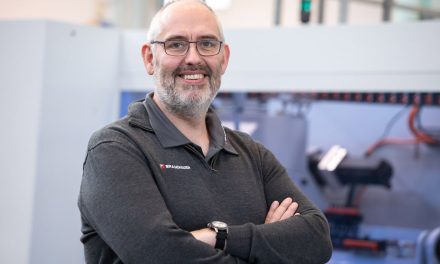 When Dr David Bryant was tasked with equipping a new braking research centre at the University of Bradford, he specified a simple set-up consisting of a standard WEG 15kW AC motor and a WEG CFW11 variable speed drive provided by Westin Drives.
When Dr David Bryant was tasked with equipping a new braking research centre at the University of Bradford, he specified a simple set-up consisting of a standard WEG 15kW AC motor and a WEG CFW11 variable speed drive provided by Westin Drives.
The avoidance of brake noise at the design stage is a major objective for vehicle manufacturers. Brake noise creates dissatisfaction amongst drivers as well as noise pollution in the environment and in the continual search to reduce these problems a new Braking Research Laboratory has been established by the School of Engineering, Design & Technology at the University of Bradford.
Professors John Fieldhouse and Andrew Day have established the new research centre in order to bring together expertise, facilities and equipment under one roof and to establish a ‘Centre of Excellence’ for the UK.
The University of Bradford operates various brake test beds for Bentley and Jaguar Land Rover, but when a fault occurred on an old servo motor on one of the test beds, Dr Bryant, research fellow for brakes engineering, reasoned that the University could save money and have a more reliable drive system by programming a standard WEG 15kW three-phase induction AC motor intelligently powered by a WEG CFW11 variable speed drive (VSD).
Dr Bryant explained: “We needed something that was up-to-date and more reliable. Plus, we needed simple speed control for the motor itself and WEG’s AC motors are well suited to this application.”
The state-of-the-art laboratory brings together new and existing specialist research test rigs including a Jaguar Land Rover 24kW single wheel quarter-vehicle brake noise rig, a 90kW judder rig, several 7.5kW rigs for individual wheel brake, vehicle axle and brake noise, vibration and harshness (NVH) research, a 45kW commercial vehicle brake NVH test rig, a light duty disc thickness variation (DTV) test rig and a heavy duty sample friction tester, plus laser holographic interferometry instrumentation, temperature measurement and data logging.
 Alongside brake noise, brake judder, the vibration felt by a driver through a vehicle’s steering wheel and suspension when the brakes are applied at certain speeds and pressures, is a major problem cited by drivers. Brake judder can result from hub or disc run-out and severe overheating or from DTV. The judder rig installation at the University required a new 90kW Motor and drive combination with a control system and this was designed, built and commissioned by Westin Drives.
Alongside brake noise, brake judder, the vibration felt by a driver through a vehicle’s steering wheel and suspension when the brakes are applied at certain speeds and pressures, is a major problem cited by drivers. Brake judder can result from hub or disc run-out and severe overheating or from DTV. The judder rig installation at the University required a new 90kW Motor and drive combination with a control system and this was designed, built and commissioned by Westin Drives.
Dr Bryant continued: “Westin Drives supplied a safety interlock control system that interfaces with the WEG inverter drive unit so that if there is a fault, we can shut down the equipment quickly. This is incredibly important as with typical high speed brake testing we might be running the brake at around 100 miles an hour, and sometimes up to 200 miles an hour. We mostly use the interface from the WEG unit itself to run the motor.
“There is also an 11kW test rig for Jaguar Land Rover where the motor drive was replaced with a WEG CFW 11 IP54. The control unit on the existing motor had similarly experienced a fault and again we needed something that would do exactly the same job quickly, which is why we opted for a WEG unit.”
Summarising his use of WEG technology at the research centre Dr Bryant concluded: “We are in the business of using a motor for an application rather than getting into the nitty-gritty of how a motor works, so we want a package that gets us up and running quickly. We installed the first WEG inverter drive early in 2013 and we now have three WEG inverter drives and two motors”.



